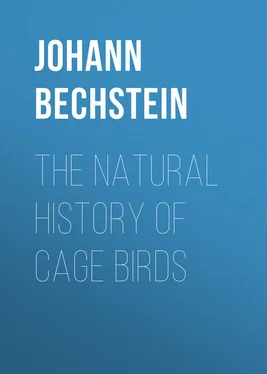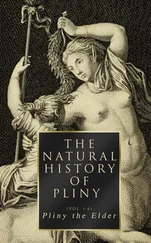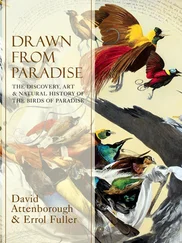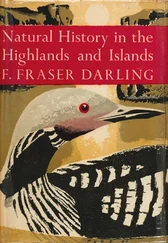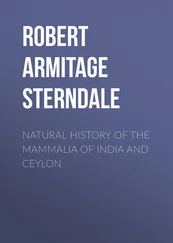Johann Bechstein - The Natural History of Cage Birds
Здесь есть возможность читать онлайн «Johann Bechstein - The Natural History of Cage Birds» — ознакомительный отрывок электронной книги совершенно бесплатно, а после прочтения отрывка купить полную версию. В некоторых случаях можно слушать аудио, скачать через торрент в формате fb2 и присутствует краткое содержание. ISBN: , Жанр: foreign_antique, foreign_prose, на английском языке. Описание произведения, (предисловие) а так же отзывы посетителей доступны на портале библиотеки ЛибКат.
- Название:The Natural History of Cage Birds
- Автор:
- Жанр:
- Год:неизвестен
- ISBN:http://www.gutenberg.org/ebooks/40055
- Рейтинг книги:4 / 5. Голосов: 1
-
Избранное:Добавить в избранное
- Отзывы:
-
Ваша оценка:
- 80
- 1
- 2
- 3
- 4
- 5
The Natural History of Cage Birds: краткое содержание, описание и аннотация
Предлагаем к чтению аннотацию, описание, краткое содержание или предисловие (зависит от того, что написал сам автор книги «The Natural History of Cage Birds»). Если вы не нашли необходимую информацию о книге — напишите в комментариях, мы постараемся отыскать её.
The Natural History of Cage Birds — читать онлайн ознакомительный отрывок
Ниже представлен текст книги, разбитый по страницам. Система сохранения места последней прочитанной страницы, позволяет с удобством читать онлайн бесплатно книгу «The Natural History of Cage Birds», без необходимости каждый раз заново искать на чём Вы остановились. Поставьте закладку, и сможете в любой момент перейти на страницу, на которой закончили чтение.
Интервал:
Закладка:
In this disorder the skin on one part of the body, or even the whole body, rises and swells to so great a degree that it is stretched like a drum. It is generally sufficient to pierce it with a pin, so as to let the air escape, and the bird will be cured. I had some larks attacked with this disease, which began again to sing a quarter of an hour after the operation.
House birds are often subject to bad feet. From the second year they become pale, and lose their freshness. They must be frequently cleaned, taking care to remove the skin; the thick loose scales ought also to be taken off, but with all possible precaution.
The gout occasions the feet to swell, they are also so scaly and painful that the poor little bird cannot support itself without resting on the points of its wings. Dr. Handel prescribes a warm fomentation with a decoction of soapwort. If a foot should be bruised or broken, he advises that the diseased bird should be shut up in a very small cage, the bottom of which is very smooth and even, without any perches, or anything which would tempt them to hop, and put in a very quiet and solitary place, out of the way of anything which might produce agitation. In this manner the bird will cure itself in a little time, without any bandage or plaster of any kind.
I am persuaded that the principal cause of bad feet is want of bathing. The scales, contracting from dryness, occasion great pain; in order to remove them with ease, and without danger, the feet must be softened in lukewarm water. I have seen the following method used with a bullfinch: – its cage was made with a moveable tin bottom, which being half or three quarters of an inch deep, could hold water, which was put in tepid, to bathe the bird; the perches were then removed, so that the bird was obliged to remain in the water, where it was left for half an hour, sometimes throwing it hemp-seed to amuse it. After repeating the bath once or twice the bird became very fond of it; and it was remarked that its feet became, if we may say so, quite young again. The scales being sufficiently softened, the middle of each was cut lengthways without reaching the flesh, this made the sides easily fall off. It is better to remove only two scales a-day, that the bird may not be wearied. By continuing the bath three times a week the feet become healthy and supple, and the bird is easy.
The juice of red-beet for drink, and also as a liniment, greatly relieves this disorder. Dr. Handel recommends washing the eyes, when disposed to blindness, with an infusion of the root of white hellebore.
As to the tumours and ulcers which come on the heads of the birds, Dr. Handel touches them with a middling-sized red hot knitting-needle. This makes the watery humour run out, the wound afterwards dries and heals. To soften the pain a little liquid black soap is used. If, from the softness of the tumour, matter seems to have formed, it should be rubbed with fresh butter until it is come to a head; it may then be emptied, and opened by a few drops of essence of myrrh. During all this time the bird must have nothing but beet juice to drink.
Ulcers in the palate and throat may be cured by making the bird drink the milk of almonds for several days, at the same time lightly touching the ulcers several times a-day with a feather dipped in a mixture of honey and borax.
Though natural, is generally accompanied with disease, during which the birds ought to be taken great care of. Their food should be changed, but without giving any heating delicacies, which are very injurious.
It has been observed that birds always moult at the time when their food is most abundant; the forest birds may then be seen approaching fields and cultivated places, where, having plenty of insects and seeds, they cannot suffer from want; indeed, the loss of their feathers prevents their taking long flights, and the reproduction of them occasions a loss of flesh which must be repaired. An abundance of food is therefore necessary, and, following this rule, during moulting some additional food must be given to house birds, appropriate to the different species – millet or canary seed, a little hemp-seed, white bread soaked in water, and lettuce, or endive, to those which feed on seeds; with a few more meal worms and ants’ eggs to those that eat insects: all should have bread soaked in boiled milk, warmth, and baths. Nothing has succeeded better than this regimen: all the birds which I have seen treated in this manner have passed their moulting season in good health.
This, without being properly a disease, is rather common, and is occasioned by the trick which the birds of the first class have, of turning their head and neck so far round that they fall head over heels. They may be easily cured of this trick by throwing a covering over the top of the cage, which prevents their seeing anything above them, for it is with looking up that this giddiness comes on.
A disease which may be called the pairing fever must not be forgotten here. House birds are usually attacked with it in May, a time when the inclination to pair is greatest. They cease to sing, become sorrowful and thin, ruffle their feathers, and die. This fever generally first seizes those which are confined in cages: it appears to arise from their way of life, which is too uniform and wearying. I cured several by merely placing them in the window, where they are soon so much refreshed that they forget their grief, their desire for liberty or for pairing, and resume their liveliness and song.
I have observed that a single female in the room is sufficient to cause this disease to all the males of the same family, though of different species. Removing the female will cure them directly. The males and females at this season must be separated, so that they cannot see or hear one another. This perhaps is the reason that a male, when put in the window, is soon cured.
AGE OF TAME BIRDS
The length of a bird’s life very much depends on the care which is taken of it. There are some parrots which have lived more than a century; and nightingales, chaffinches, and goldfinches have been known to live more than twenty-four years in a cage. The age of house birds is so much the more interesting, as it is only by observing it that we can know with any degree of certainty the length of birds’ lives in general. Thus house birds are of importance to the naturalist, as giving him information which he could not otherwise acquire. It is worthy of remark, that the quick growth of birds does not prevent their living much longer than quadrupeds. The length of life with these is estimated to be six or seven times longer than the time which they take to grow: while birds live fifteen, twenty, and even thirty times longer.
This length of life is sometimes attributed to the substance of which the bones are composed being much more loose and light, and consequently remaining porous longer than those of quadrupeds. Some swans have lived three hundred years.
BIRD CATCHING
We are furnished with house birds by the bird catchers and bird sellers; the latter procure foreign birds, and teach them, the former the indigenous ones. A good bird catcher ought to know not only the different modes of taking birds, but also all the calls for attracting the different species and sexes: the call notes vary very much among house birds, according to their passions and wants; thus the common chaffinch, when calling its companions, often repeats iack , iack ; when expressing joy, fink , fink , which it also does when angry, though louder and more quickly; whilst its cry of sorrow is treef , treef .
Читать дальшеИнтервал:
Закладка:
Похожие книги на «The Natural History of Cage Birds»
Представляем Вашему вниманию похожие книги на «The Natural History of Cage Birds» списком для выбора. Мы отобрали схожую по названию и смыслу литературу в надежде предоставить читателям больше вариантов отыскать новые, интересные, ещё непрочитанные произведения.
Обсуждение, отзывы о книге «The Natural History of Cage Birds» и просто собственные мнения читателей. Оставьте ваши комментарии, напишите, что Вы думаете о произведении, его смысле или главных героях. Укажите что конкретно понравилось, а что нет, и почему Вы так считаете.
